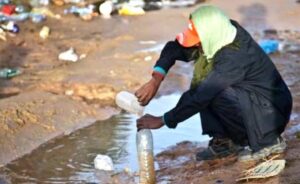
Source: Offshore Technology
I have never really thought deeply into how much water I consume on a daily basis-especially through the food I eat and other virtual uses. After calculating my consumption through the water footprint calculator, I discovered I use 1,869 gallons on an average day. For a weekly basis, the minimum amount of water I use is 8,783 gallons with 13,083 being the maximum. This comes to a total of anywhere from 456,753 to 682,185 gallons a year when using the two different calculators. This difference between my two footprints does cause confusion and illustrates how imprecise these calculations can be.
The average US citizen uses 1,802 gallons a day which is a little below of what I use. When looking at the Middle East and North Africa region, the water use varies drastically between the countries. Water is one of the sectors that highlights unequal distribution and concentrated power in this region. Water usage amongst the North Africa region is not as asymmetrical as the Middle Eastern countries, but there are still differences. Egypt has the lowest water usage per capita with it only being 977 gallons a day while Tunisia has the highest, with 1,611 gallons a day per capita. Libya, Algeria, and Morocco have similar per capita water usages ranging from 1,162 gallons to 1,479 gallons.
Although, we need to take into account how much of this water is external and the consumption per year a s a whole. Egypt may have the lowest water footprint per capita but they have the lowest external rate of 29% and they use around 25 million gallons a year as a country. On the other hand, Tunisia has the highest per capita but only uses 5,547,613 million gallons a year as a country. They also have a higher external rate than Egypt, with 32% being imported from somewhere else. Also, Libya has the second highest per capita rate but 65% of their water source is external. Moreover, Algeria has the second highest external rate of 51% and a nationwide footprint of 13 million gallons a year. 13 million gallons is not a high amount when looking at the size of the country especially since it is bigger than Egypt.
It can be implied that the countries who have the highest external amounts of water are not as self-sufficient as others. Algeria, and Libya have struggled with high water demands and lack of supply to meet those demands, leading to more imports to suffice. They have to save water for drinking needs and have less to use on agriculture, so they need to enforce virtual water uses on food. So, while they are trying to be more rational and sustainable with water, this creates a dependency on other countries and states, and when the market is bad these countries struggle economically. For Egypt, there is an implication of inequality due to the high-water usage as a country but low usage per person. This water most likely goes towards agriculture and oil drilling, and results in poor sustainability practices.

source: The Ecologist
The water scarcity that is prevalent in this region should be a tool for cooperation and peace because of a shared threat, but it has not reached this point yet. Countries are either having to sacrifice agricultural exports and independence or sacrifice the needs of the most vulnerable people. It is hard to find a balance in this region because of the years of imperialism that has resulted in a late start towards industrialization, a balanced economy, food security, etc. These countries are not worried about sustainability in the midst of the climate emergency because it is not the most prominent national security interest especially when water is scarce, and institutions are weak. In the future, it is likely there will be a war on water because solutions such as water virtuality and desalination are not sustainable in the sense that they open the door for new issues.
Sources
Leave a Reply